Pears Poached in Passito with Mugolio Cream
Their gentle sway, the round bottom that nestles in my hand, the succulent flesh of a perfectly ripe Comice – I love pears. Succulent and sexy, whether roasted in cream and sugar, baked into a tart or cake, transformed on the stove top into Pear Vanilla Butter, or eaten out of hand, pears are one of the gustatory delights of Winter.
I have a vivid recollection of my first taste of poached pears. Bosc pears, firm and tall with their stems intact, had been peeled and gently poached in sweetened, spiced Port wine. Their flesh yielding to a paring knife, the hostess lifted them from the garnet liquid and placed them in a pool of thick Creme Anglaise. She increased the flame under the poaching liquid and reduced it to a syrup. She dotted the Creme Anglaise with the syrup and deftly ran a paring knife through the dots, connecting them in an elephant walk chain made of linked hearts. A beautiful dessert took shape before my eyes, and I was transfixed. It changed the way I thought about food, and certainly how I thought about pears. It was one of those moments one never forgets, and although the word may be overused, it was a revelation.
It’s such a simple preparation – pears enrobed in sweet syrup and served after a winter’s feast. Even less than perfect pears are wonderful when poached. The possibilities for poaching liquids are limited only by the imagination of the cook. From water sweetened with sugar or honey and flavored with vanilla, citrus zest and spices such as cinnamon, star anise, cloves and allspice to wines of every color and sweetness level, the choices are endless.
Sweet wines result in particularly succulent fruit, and these days wonderful and wonderfully inexpensive sweet wines abound.
For a real treat, try a Passito from the tiny windswept island of Pantelleria.
The island’s volcanic soil gives rise to one of Italy’s most wonderful grapes, Zibbibo (the Arabic name for Muscat of Alexandria), from which this fine dessert wine is made.
Harvested in late August and September, the grapes for this DOC wine are left out on mats to dry, a wine making technique known as apassimento.
Complex and sweet, with a dark honeyed hue, the wine complements the pears beautifully.
The pears may be served warm, at room temperature or chilled. The poaching liquid is reduced to a thick vanilla-flecked amber syrup, drenching the pears with the wine’s precious essence. The pears are delicious served with their syrup alone, but a dollop of Mascarpone Cream flavored with Mugolio adds extra dimension to this dessert.
Mugolio is a thick syrup made from the buds of Pinus mugo, the Mountain Pine – a high altitude evergreen shrub. In May, high in the Dolomites Eleanora Cunacia, owner of Primitivizia, gathers the buds. She sets the buds, known as gems, in pots, leaving them to cure under the summer sun. Through the summer months the gems exude a golden essence, and in late Autumn the liquid is collected, filtered, mixed with sugar and reduced over heat. The result is Mugolio, a sweet resinous elixir redolent of pine and rosemary with a hint of raspberry. There is no end to the ways you can use Mugolio. Some recommend using it on pancakes or French toast in place of maple syrup. It is a brilliant match for roast pork and drizzled over the meat will lift panini to new heights. I like to dribble a bit over ricotta or Pecorino. For a real treat, try it with Taleggio and serve a few succulent Comice pears along side. Mugolio’s dark, resinous notes and honey-like taste are a beautiful match for these Passito poached pears.
Poached Pears with Mugolio and Mascarpone Cream
serves 4 left whole or 8, if pears are halved
4 pears, Bosc or Bartlett
1 bottle (500 ml) Passito di Pantelleria
3 cups water
1 cup granulated sugar
1 3-inch strip of lemon peel – peel only, no white pith
1 vanilla bean, split
juice of 2 lemons
8 ounces Mascarpone
7-8 tablespoons heavy cream
2 tablespoons superfine or confectioner’s sugar
3-4 tablespoons Mugolio
Fill a large bowl ¾ full with cool water and add lemon juice. This water is now said to be acidulated, because of the citric acid in the lemon juice; it will prevent the pears from oxidizing and turning brown. Peel the pears, placing each peeled pear in the acidulated water.
If the pears are to be served halved, cut them lengthwise, top to bottom. Core them using a melon baller and use a small paring knife to remove the tough flesh near the bottom. Place the halved and cored pears in the acidulated water.
Combine the Passito, water and sugar in a 4-quart high sided saucepan. Heat the mixture over medium heat, stirring occasionally, until the sugar has completely dissolved. Bring the mixture to a boil, and reduce to a very gentle simmer. Add the lemon zest strips, split vanilla bean and the prepared pears.
Cut a round of parchment paper large enough to cover the surface of the saucepan and place it atop the pears. This will keep the top surfaces of the pears moist. Poach the fruit, keeping the liquid at a gentle simmer, until a paring knife slides in easily, about twenty to thirty minutes. The pears may take more or less time to poach, depending on their firmness when uncooked.
The recipe may be completed up to this point a day in advance. To store the pears overnight, remove and discard the lemon zest, leaving the vanilla bean. Transfer the pears, the poaching liquid and the vanilla bean to a glass container, being sure pears are submerged. Place a fresh piece of parchment atop pears. Dampen parchment with poaching liquid. Cover container tightly with several layers of plastic wrap and refrigerate overnight.
To serve, place the pears on serving plates. Remove the lemon zest and vanilla from the poaching liquid. Increase the heat to high, and bring the poaching liquid to a boil. Reduce it to a thick syrup.
While the syrup reduces, make the Mugolio Cream. Place the mascarpone, cream, superfine or confectioner’s sugar and 3 tablespoons of Mugolio in a medium bowl. Whisk gently until mixture mounds gently. Taste, adding more Mugolio, if desired.
Drizzle a bit of syrup over each pear, allowing it to pool around the fruit. Place a dollop of Mascarpone Mugolio Cream on the plate and, if desired, drizzle a bit of Mugolio over the pear and cream.
Mugolio is available from Olio2Go
Note: You can click on any picture for a larger image, and to see a slide show!
I have no affiliation with any product, manufacturer, or site mentioned in this article.
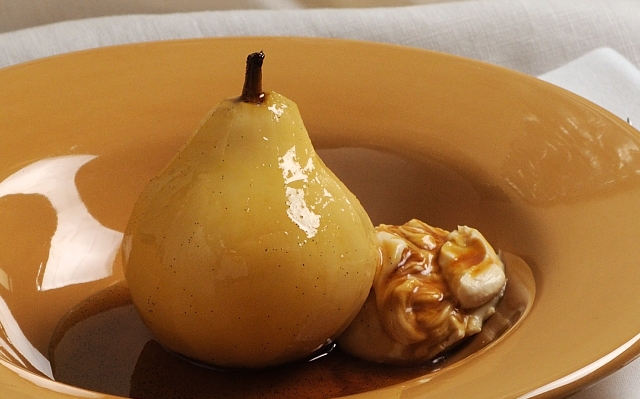
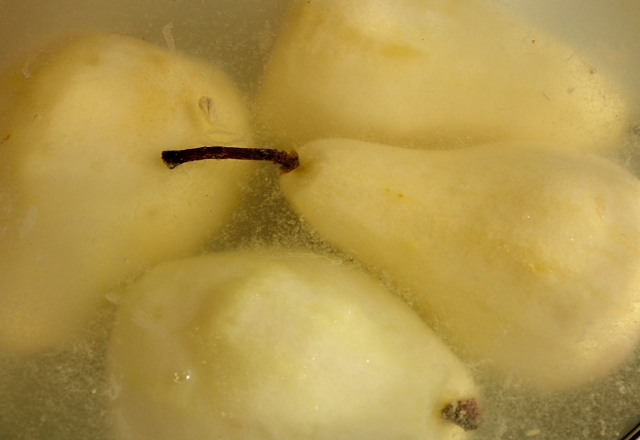
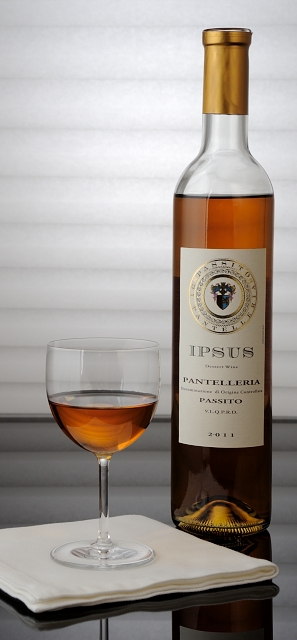
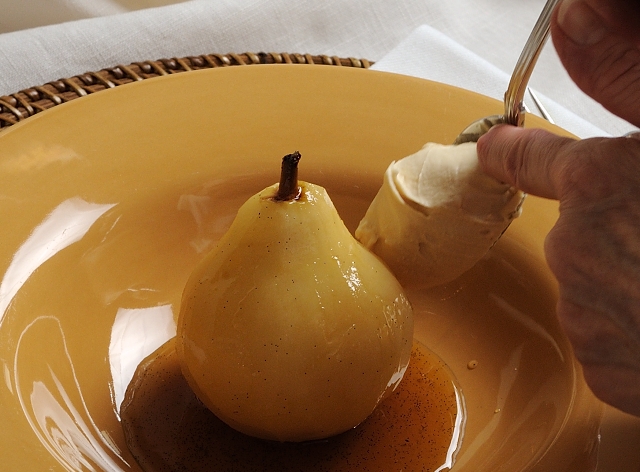
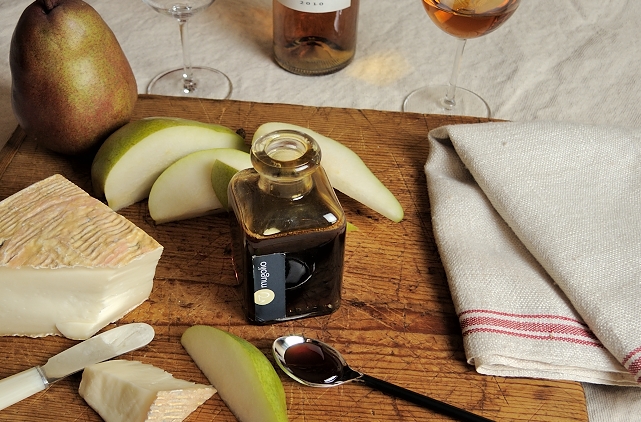

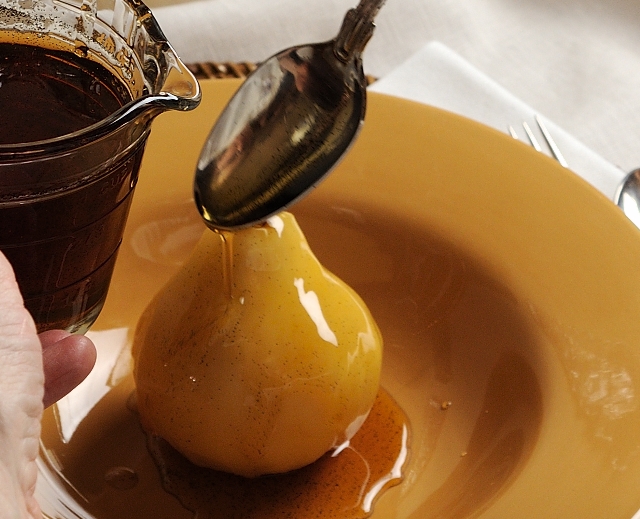
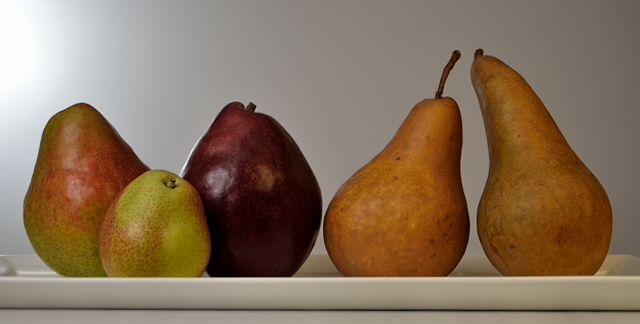

Wednesday, January 8th 2014 at 11:02 pm |
My but what a beautiful recipe. I love the way you write too. You describe food and wine so lovingly.
Thursday, January 9th 2014 at 7:22 am |
HI Pam,
Thank you. Pears inspire me! Best wishes to you and yours for a happy and healthy 2014!
Friday, January 10th 2014 at 3:04 am |
Che bella proposta! Molto golosa!
Friday, January 10th 2014 at 7:03 am |
Grazie, Emanuela!
Saturday, January 11th 2014 at 5:17 pm |
What an ELEGANT recipe, Adri and I simply must try Passito . . . so grateful that you’ve educated me about something that I’ve never known about!
May 2014 hold many blessings in store for you. I am so happy to have found you this past year and look forward to all of your delicious and delightful recipes and posts in the coming year!
I also want to thank you for being such a nice contributor to the Facebook group of Italian Cuisine, Culture and Travel. You’ve been amazing!
Ciao,
Roz
Sunday, January 12th 2014 at 7:20 am |
Hi Roz,
You’ll love Passito!
And thank you for the kind words. It has been a pleasure to get to know you. Alla prossima!
Sunday, January 12th 2014 at 10:47 am |
I’ve never had Passito, but it sounds wonderful! I love poached pears – such an elegant and flavorful dessert. I totally need to make this – thanks.
Sunday, January 12th 2014 at 10:57 am |
Ciao John,
Passito is wonderful, and if you can’t find it, a Moscato would be great. Trader Joe’s often has the Ipsus Passito, so if you have a store near you, take a look. I hope you enjoy this! Happy New Year to you!
Monday, January 13th 2014 at 2:11 pm |
I have never tried the Pssito either,but now am tempted..:) If it can be found here..
And I love pears..the shape..s color..s
Monday, January 13th 2014 at 2:43 pm |
Hi Monique,
I hope you try it. I bet you will be able to find this lovely pantescan wine. If not, try a Moscato. Buon anno a te!
Tuesday, January 14th 2014 at 5:00 am |
I don’t think I’ve ever seen more gorgeous poached pears. Your photos are superb. I’ve never had much luck with pears, either they are too hard or too ripe or end up having spots. You’ve definitely inspired me, and also to find Passito, which I’m not familiar with. Lovely post.
Sam
Tuesday, January 14th 2014 at 7:18 am |
Hi Sam,
I hope you keep trying with the pears. Not every pear poaches up perfectly, but after a bit you will get a feel for the ones that are ripe for the poaching, so to speak. If you have a Trader Joe’s near you, look on their wine shelves. All their stores near me here in Southern California carry it, and if they do not have it, ask. They can be very accommodating. Thank you for stopping by and for the kind words. Happy New Year to you!
Wednesday, January 15th 2014 at 11:45 am |
I think your poached pear dish is just gorgeous. It has to be delicious the way you prepared it.
Wednesday, January 15th 2014 at 3:19 pm |
Hi Karen,
We all enjoyed it. I hope you try it. There is something so very special about poached pears. I can just imagine a large, low bowl filled with these pears sitting on the table in your gorgeous dining room. Happy New Year to you!
Friday, January 17th 2014 at 6:49 pm |
Hi Adri, oh, my I don’t know where to begin…so much to love about this post—the food memory, the glistening pears, the information about mugolio (never heard of it before now!) Inspired!
Friday, January 17th 2014 at 10:02 pm |
Hi Nancy,
Happy New Year to you! I am so glad you like this. I am wild about pears, and I hope you try the Mugolio. It really is unique.
Monday, July 4th 2016 at 2:09 pm |
We make Pine Bud Syrup at http://www.ionsyrup.com ours are from the Transylvanian pines and we sell in the London market but looking to bring to USA. If you would be happy to pass this onto your readers, that would be greatly appreciated. It’s a great flavour.
Monday, July 4th 2016 at 4:16 pm |
Benvenuta Judi,
I hope I can soon find your Pine Bud Syrup here in the U.S. I would love to try it. Until then I shall prevail upon my traveling friends to bring a bottle back for me on their next trip to London. Thank you so much for stopping by and for telling me about your Pine Bud Syrup.
Tuesday, July 5th 2016 at 12:04 pm |
I will be trying to send some samples soon. I will let you know.
Thursday, July 7th 2016 at 11:06 am |
Ciao Judi,
It’s a pleasure to meet you. I visited Ion Syrup, and there is so much good info there. I am really curious about the various types of syrup. I had no idea there were “variations on a theme.” Plus, I would like to compliment you on the photography. It is most enticing, and your blog is terrific. Thank you so much for contacting me.